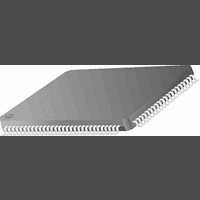PC87393VJG National Semiconductor, PC87393VJG Datasheet - Page 96

PC87393VJG
Manufacturer Part Number
PC87393VJG
Description
IC, SUPER I/O DEVICE, TQFP-100
Manufacturer
National Semiconductor
Specifications of PC87393VJG
Data Rate
2Mbps
Supply Voltage Range
3V to 3.6V
Logic Case Style
TQFP
No. Of Pins
100
Operating Temperature Range
0°C to +70°C
Termination Type
SMD
Transceiver Type
Interface
Rohs Compliant
No
Available stocks
Company
Part Number
Manufacturer
Quantity
Price
Part Number:
PC87393VJG
Manufacturer:
NS/国半
Quantity:
20 000
- Current page: 96 of 148
- Download datasheet (2Mb)
6.0 Musical Instrument Digital Interface (MIDI) Port
Note: This section applies to the PC87393 and PC87393F only.
6.1 OVERVIEW
This chapter describes a generic MIDI Port. For the implementation used in this device, see the Device Architecture and
Configuration chapter.
The MIDI Port is an asynchronous receiver/transmitter that uses a two-wire, bi-directional, relatively slow communication
channel to transmit and receive data bytes to or from MIDI-compliant devices, according to a predefined communication pro-
tocol. The MIDI Port is compatible with MPU-401 UART mode.
The MIDI was originally defined to establish a standard interface between computers and digital musical instruments such
as synthesizers, and has become the de facto standard for this purpose. However, the MIDI is also commonly used for other
purposes, such as communicating with advanced game devices.
The MIDI Port serves as a communication pipe between software and a MIDI device. The software and the MIDI device must
interpret the data they exchange, and act accordingly.
The MIDI Port supports the following two feature types:
Legacy. These include all features supported by MPU-401 UART mode. They can all be operated via the Legacy I/O ad-
dress space of 2 bytes, traditionally allocated for the MIDI Port.
Enhanced. These features extend the capabilities of the MIDI Port. They can only be operated if the MIDI is allocated with
an address space of at least 3 bytes.
The basic system configuration of the MIDI Port consists of the port itself, a single pull-up resistor for the MDRX pin, and a
MIDI compliant device. This system configuration is shown in Figure 17. The purpose of the pull-up resistor is to make sure
that the MIDI Port senses an inactive (high) MIDI receive signal in the absence of a MIDI device.
6.2 FUNCTIONAL DESCRIPTION
The MIDI Port consists of five major functional blocks:
See Figure 18 for a block diagram of the MIDI Port.
Legacy (MPU-401)
Enhanced.
Internal Bus Interface Unit
Port Control and Status Registers
Data Buffers and FIFOs
MIDI Communication Engine
MIDI Signals Routing Control Logic.
MIDI
Port
MIDI Transmit
MIDI Receive
Figure 17. MIDI System Configuration
MDRX Pin
MDTX Pin
96
R
MIDI Transmit
MIDI Receive
Device
MIDI
Device
Game
www.national.com
Related parts for PC87393VJG
Image
Part Number
Description
Manufacturer
Datasheet
Request
R
Part Number:
Description:
National Semiconductor [8-Bit D/A Converter]
Manufacturer:
National Semiconductor
Datasheet:
Part Number:
Description:
National Semiconductor [Media Coprocessor]
Manufacturer:
National Semiconductor
Datasheet:
Part Number:
Description:
Digitally Controlled Tone and Volume Circuit with Stereo Audio Power Amplifier, Microphone Preamp Stage and National 3D Sound
Manufacturer:
National Semiconductor
Datasheet:
Part Number:
Description:
Digitally Controlled Tone and Volume Circuit with Stereo Audio Power Amplifier, Microphone Preamp Stage and National 3D Sound
Manufacturer:
National Semiconductor
Datasheet:
Part Number:
Description:
AC97 Rev 2 Codec with Sample Rate Conversion and National 3D Sound
Manufacturer:
National Semiconductor
Part Number:
Description:
Manufacturer:
National Semiconductor
Datasheet:
Part Number:
Description:
Manufacturer:
National Semiconductor
Datasheet:
Part Number:
Description:
General Purpose, Low Voltage, Low Power, Rail-to-Rail Output Operational Amplifiers
Manufacturer:
National Semiconductor
Datasheet:
Part Number:
Description:
8-bit 20 MSPS flash A/D converter.
Manufacturer:
National Semiconductor
Datasheet:
Part Number:
Description:
Low Noise Quad Operational Amplifier
Manufacturer:
National Semiconductor
Datasheet:
Part Number:
Description:
Quad Differential Line Receivers
Manufacturer:
National Semiconductor
Datasheet:
Part Number:
Description:
Quad High Speed Trapezoidal? Bus Transceiver
Manufacturer:
National Semiconductor
Datasheet:
Part Number:
Description:
Dual Line Receiver
Manufacturer:
National Semiconductor
Datasheet:
Part Number:
Description:
TTL to 10k ECL Level Translator with Latch
Manufacturer:
National Semiconductor
Datasheet:











